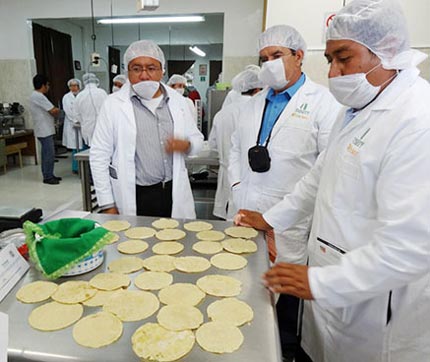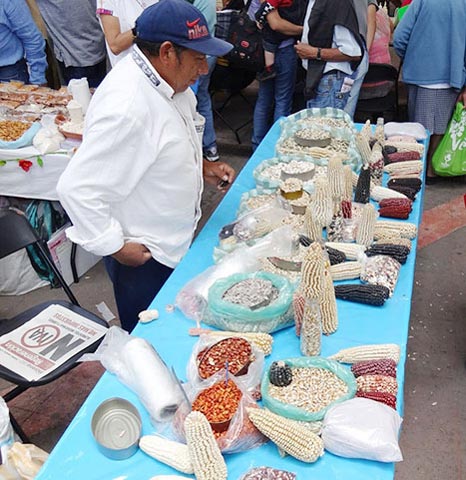By Natalia Palacios, CIMMYT
 Mexico is the fifth highest maize-consuming country in the world. It is also the number one consumer of maize for food, given that its population eats 70 percent of available maize grain every year. The national food maize groups included in this percentage can be divided into three main types: home consumption, the nixtamalized flour industry and the maize dough and tortilla industry. Businesses in the latter sector must supply maize grain of uniform quality so that maize processing will be more efficient, stable and profitable. With this in mind, 30 Mexican dough and tortilla manufacturers, grain marketers and seed producers attended a practical training course entitled “Maize Grain Quality and Technology” given by researchers from the Sustainable Modernization of Traditional Agriculture (MasAgro) initiative from 2 to 3 September in the Cereals Laboratory of the School of Agroindustrial Engineering of the Autonomous University of Chapingo (UACh).
Mexico is the fifth highest maize-consuming country in the world. It is also the number one consumer of maize for food, given that its population eats 70 percent of available maize grain every year. The national food maize groups included in this percentage can be divided into three main types: home consumption, the nixtamalized flour industry and the maize dough and tortilla industry. Businesses in the latter sector must supply maize grain of uniform quality so that maize processing will be more efficient, stable and profitable. With this in mind, 30 Mexican dough and tortilla manufacturers, grain marketers and seed producers attended a practical training course entitled “Maize Grain Quality and Technology” given by researchers from the Sustainable Modernization of Traditional Agriculture (MasAgro) initiative from 2 to 3 September in the Cereals Laboratory of the School of Agroindustrial Engineering of the Autonomous University of Chapingo (UACh).
Representatives from UACh, the National Forestry, Agricultural, and Livestock Research Institute (INIFAP) and CIMMYT studied the effects that physical, structural and chemical grain characteristics have on tortilla appearance and the tortilla-making process. Course participants tried several simple methods for evaluating grain quality and the efficiency of tortilla making. They also did some very basic testing to determine the quality of the tortillas they made. “By using these lab techniques and processing maize grain with different textures and colors, and seeing the difference it makes in the appearance, texture and color of the tortillas, I acquired the tools I need to evaluate the grain I buy for my business,” said one of the participants. “Up to now, I’ve constantly been adjusting the process and mixing different types of grain and I always get the same quality, but sometimes I don’t get it right and I lose a lot of money.”
 After exchanging their experiences, businessmen, grain merchants and seed producers showed interest in revising Mexican Regulation (Norma Mexicana) 034-1 on grain quality to make the range of values match the current dough- and tortilla-making process. In their opinion, the different links of the maize production chain are increasingly demanding when it comes to the raw materials, processes and products they use. For this reason, Gricelda Vázquez of INIFAP’s Valley of Mexico Experiment Station (CEVAMEX) thinks continued collaboration among research and industrial institutions is needed to ensure that research results extend beyond the production process. As David Tecotl pointed out, “Only by attending these courses at the university do we acquire firsthand knowledge of these important alternatives.” He and his fellow trainees tested the best techniques for mixing nixtamalized flour (of bean, barley, oat, amaranth, and maize) to make more nutritionally rich tortillas, as did the UACh students who are doing their Ph.D. research under the supervision of Ofelia Buendía, one of the course organizers.
After exchanging their experiences, businessmen, grain merchants and seed producers showed interest in revising Mexican Regulation (Norma Mexicana) 034-1 on grain quality to make the range of values match the current dough- and tortilla-making process. In their opinion, the different links of the maize production chain are increasingly demanding when it comes to the raw materials, processes and products they use. For this reason, Gricelda Vázquez of INIFAP’s Valley of Mexico Experiment Station (CEVAMEX) thinks continued collaboration among research and industrial institutions is needed to ensure that research results extend beyond the production process. As David Tecotl pointed out, “Only by attending these courses at the university do we acquire firsthand knowledge of these important alternatives.” He and his fellow trainees tested the best techniques for mixing nixtamalized flour (of bean, barley, oat, amaranth, and maize) to make more nutritionally rich tortillas, as did the UACh students who are doing their Ph.D. research under the supervision of Ofelia Buendía, one of the course organizers.
 Capacity development
Capacity development